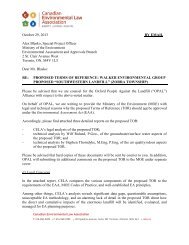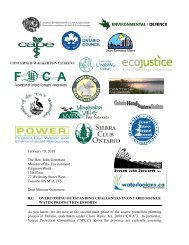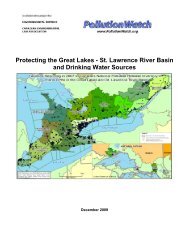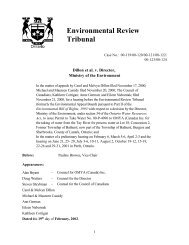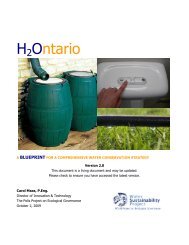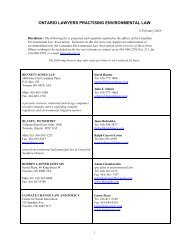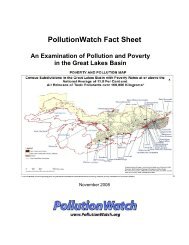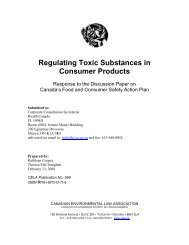APPLICANTS' MEMORANDUM OF FACT AND LAW PART I ...
APPLICANTS' MEMORANDUM OF FACT AND LAW PART I ...
APPLICANTS' MEMORANDUM OF FACT AND LAW PART I ...
Create successful ePaper yourself
Turn your PDF publications into a flip-book with our unique Google optimized e-Paper software.
APPLICANTS’ <strong>MEMOR<strong>AND</strong>UM</strong> <strong>OF</strong> <strong>FACT</strong> <strong>AND</strong> <strong>LAW</strong><br />
<strong>PART</strong> I – CONCISE STATEMENT <strong>OF</strong> <strong>FACT</strong>S<br />
A. Overview<br />
1. This is an application for judicial review in relation to a federal environmental<br />
assessment (“EA”) conducted by a Joint Review Panel (“JRP” or “Panel”). The<br />
respondents Minister of the Environment (“Minister”) and Canadian Nuclear Safety<br />
Commission (“CNSC”) established the JRP to conduct an EA and licencing review for<br />
the Darlington New Nuclear Power Plant Project (“the Project”) proposed by Ontario<br />
Power Generation (“OPG”).<br />
2. The applicants’ overall position is that in conducting the EA, the JRP failed to<br />
comply with the mandatory requirements of the Canadian Environmental Assessment<br />
Act, S.C. 1992, c.37 (“CEAA”) and the JRP’s own Terms of Reference.<br />
3. As a matter of law, the JRP failed to conduct an EA of a “project” within the<br />
meaning of the CEAA, and further failed to consider the mandatory factors prescribed<br />
by section 16 of the CEAA and the JRP’s Terms of Reference. In addition, the JRP<br />
failed to comply with the legal duties imposed by section 34 of the CEAA in relation to<br />
information-gathering, public participation, and reporting.<br />
Moreover, the JRP has<br />
unlawfully attempted to defer or delegate its section 34 duties to other entities and<br />
agencies in the post-EA period. Accordingly, the applicants respectfully request that<br />
this Honourable Court, inter alia, issue an order remitting the EA back to the JRP for<br />
further consideration in accordance with the legal requirements of the CEAA.<br />
B. The Provincial Project and the Federal EA Process<br />
4. In 2006, OPG’s sole shareholder (the Government of Ontario) directed it to<br />
seek federal approvals for the development of new nuclear units “at an existing site”,
2<br />
which was later specified by the Government of Ontario as the Darlington Nuclear<br />
Generating Station (“NGS”).<br />
Applicants’ Record [“AR”], Vol. 1, Tab 2: JRP Report, p.1<br />
5. OPG’s proposed nuclear “new build” is a plan for the site preparation,<br />
construction, operation, decommissioning and abandonment of “up to” four new<br />
nuclear reactors at the Darlington NGS, which is located on the Lake Ontario shoreline<br />
in the Municipality of Clarington, Ontario. Among other things, this will include<br />
nuclear power reactor buildings, containment structures, nuclear fuel management and<br />
storage, electrical turbine systems, condenser cooling technology, lake infilling, fish<br />
habitat alteration, stormwater management, air and water discharge systems,<br />
management of conventional and hazardous wastes, on-site storage of radioactive<br />
wastes, and ancillary buildings.<br />
AR, Vol. 1, Tab 2: JRP Report, pp.1, 13-16; AR, Vol. 4, Tab 4: Affidavit of Kathleen<br />
Cooper, paras.48-52; and Exhibit A: OPG Project Description (April 12, 2007), pp.11-19<br />
6. After OPG filed an application for a Licence to Prepare a Site under the Nuclear<br />
Safety and Control Act, S.C. 1997, c.9 (“NSCA”) in 2006, the CNSC advised OPG that<br />
a CEAA assessment was required because the Law List Regulations (SOR/94-636)<br />
prescribe the NSCA licence under the CEAA. The Project also required other federal<br />
approvals that are prescribed by the CEAA Law List Regulations as triggers for EA (i.e.<br />
authorizations under subsection 35(2) of the Fisheries Act, R.S.C. 1985, c.F-14, and<br />
subsection 5(1)(a) of the Navigable Waters Protection Act, R.S.C. 1985, c.N-22).<br />
While parts of the Project will require future additional licences under the NSCA (e.g.<br />
to construct, operate, decommission, and abandon the facility), the federal EA at issue<br />
in this case is the only EA that will be carried out for this Project as a whole.<br />
AR, Vol. 1, Tab 2: JRP Report, p.5; AR, Vol. 4, Tab 4: Affidavit of Kathleen Cooper,
3<br />
paras.55-57; AR, Vol. 6, Tab 5: Affidavit of Mark Mattson, para.52<br />
7. In 2008, the Minister, acting on the request of the CNSC, referred the Project to<br />
a review panel pursuant to section 29 of the CEAA.<br />
AR, Vol. 4, Tab 4: Affidavit of Kathleen Cooper, paras.59-61<br />
8. In January 2009, the Minister and the CNSC signed an Agreement to establish<br />
the JRP for the Project pursuant to section 40 of the CEAA. Under the Agreement, two<br />
panel members were to be appointed by the CNSC, and one panel member was to be<br />
proposed by the Minister to the President of the CNSC. The Agreement also fixed the<br />
Terms of Reference for the JRP pursuant to section 41 of the CEAA, and fulfilled the<br />
Minister’s duty to determine the factors that the JRP was to consider pursuant to<br />
subsection 16(3)(b) of the CEAA. The Agreement further specified that it did not limit<br />
the JRP’s consideration of the matters listed in subsections 16(1) and (2) of the CEAA<br />
(see below). In short, the dual mandate of the JRP was to conduct the EA required<br />
under the CEAA, and to review OPG’s application under the NSCA for a licence to<br />
prepare the Darlington site. For this latter purpose, the JRP was also constituted as a<br />
panel of the CNSC for the purposes of section 24 of the NSCA.<br />
AR, Vol. 1, Tab 2: JRP Report, p.6; AR, Vol. 4, Tab 4: Affidavit of Kathleen Cooper,<br />
paras.65-66; Exhibit I: JRP Agreement, sections 2.2, 3.1, 3.2, 4.1, 4.2 and Appendix -<br />
Terms of Reference (January 2009)<br />
9. In September 2009, OPG filed an Environmental Impact Statement (“EIS”),<br />
supporting documents, and a revised application for the NSCA site licence. The EIS is<br />
not the EA that the JRP was required to conduct under the CEAA; instead, the EIS is<br />
the proponent’s written report provided to the JRP during the EA.<br />
AR, Vol. 1, Tab 2: JRP Report, p.6; AR, Vol. 4, Tab 4: Affidavit of Kathleen Cooper,<br />
paras.64, 68; Exhibit G: EIS Guidelines for the Project (March 2009); Respondent’s<br />
Record (OPG): Affidavit of Lauri Swami, Exhibit 10: OPG EIS (September 30, 2009)<br />
10. When OPG filed its EIS, no specific nuclear reactor type had been selected for
4<br />
the Project. Nor was the overall site development set out completely in the EIS<br />
because development requirements (and other factors) are unique to each reactor type,<br />
and therefore cannot be identified without first determining the reactor type. Instead,<br />
OPG undertook what it called a “bounding approach” (or “plant parameter envelope”<br />
or “bounding scenario”) to evaluate a hypothetical hybrid based upon the three reactor<br />
technologies under consideration at the time (i.e. ACR-1000, US EPR, and AP1000).<br />
The Enhanced C<strong>AND</strong>U-6 reactor technology (EC-6) was not included or assessed in<br />
the EIS. As described below, the “bounding approach” contributed to the JRP’s failure<br />
to meet its legal duties under the CEAA.<br />
AR, Vol. 4, Tab 4: Affidavit of Kathleen Cooper, para.69; Respondent’s Record (OPG):<br />
Affidavit of Lauri Swami, Exhibit 10: OPG EIS (September 30, 2009), pp.ES2-ES3, 1-15-<br />
1-16, 2-10, 2-13<br />
11. In October 2009, three persons were appointed to the JRP in accordance with<br />
the Agreement. The JRP members undertook various review activities, including a<br />
public hearing in relation to the Project, as described below.<br />
AR, Vol. 1, Tab 2: JRP Report, pp.7-8; AR, Vol. 4, Tab 4: Affidavit of Kathleen Cooper,<br />
paras.70-98<br />
12. The applicants, which are non-profit public interest organizations with a lengthy<br />
history of involvement and demonstrated interest in nuclear issues and environmental<br />
protection, participated as interveners during the JRP’s pre-hearing proceedings and the<br />
JRP’s public hearings on the Project.<br />
AR, Vol. 1, Tab 3: Affidavit of Shawn-Patrick Stensil, paras.16-81; AR, Vol. 4, Tab 4:<br />
Affidavit of Kathleen Cooper, paras. 6, 47, 63, 74, 77, 79, 82, 84, 87, 89, 91, 95, 96; AR,<br />
Vol. 6, Tab 5: Affidavit of Mark Mattson, paras.22-80; AR, Vol. 7, Tab 6: Affidavit of<br />
Brennain Lloyd, paras. 13-39<br />
13. Just before the close of the JRP’s pre-hearing public comment period on OPG’s<br />
EIS, the applicants learned that the EC-6 reactor technology would be added as a fourth<br />
design to be assessed within the EA conducted by the JRP. Since the EC-6 technology
5<br />
poses health and environmental risks which significantly differ from those arising from<br />
the three reactor designs addressed in the EIS, the applicants objected to the late<br />
inclusion of the EC-6 design on fairness grounds and other reasons. However, these<br />
objections were overruled by the JRP. The JRP thus permitted OPG to revise its “plant<br />
parameter envelope” (after the public comment period on the EIS) to include the EC-6<br />
option.<br />
AR, Vol. 1, Tab 2: JRP Report, p.12; AR, Vol. 1, Tab 3: Affidavit of Shawn-Patrick<br />
Stensil, paras.56-60, 65-77; AR, Vol. 4, Tab 4: Affidavit of Kathleen Cooper, paras.76-78,<br />
84-85, 87; Exhibit P: Joint Letter to JRP (October 5, 2010); Exhibit W: Joint Letter to the<br />
JRP (March 3, 2011); Exhibit Y: CELA Letter to the JRP (March 14, 2011)<br />
14. From March 21 until April 8, 2011, the JRP held a 17 day public hearing. After<br />
the hearing ended, the JRP accepted further evidence from two participants (OPG and<br />
the Ontario Ministry of Energy) provided through answers to Undertakings 75 and 76,<br />
to which other participants (including the applicants) were not provided an opportunity<br />
to file responding evidence. In June 2011, the JRP announced that it had obtained and<br />
made public all of the information needed to prepare its Report, and the JRP closed the<br />
record for the EA.<br />
AR, Vol. 1, Tab 2: JRP Report, pp.8, 23-25; AR, Vol. 4, Tab 4: Affidavit of Kathleen<br />
Cooper, paras.98-99; and Vol. 5, Exhibit JJ: JRP Announcement (June 3, 2011)<br />
C. Release of the JRP Report on the Project<br />
15. On August 25, 2011, the JRP published its EA Report regarding the Project.<br />
The Report identified numerous significant gaps in the data, information, methodology<br />
and analysis needed to fully assess the Project’s environmental effects or to identify<br />
specific mitigation measures or the requirements of follow-up programs. The Report<br />
made a number of recommendations in an effort to fill these gaps in information<br />
through processes other than an EA under the CEAA.<br />
AR, Vol. 1, Tab 2: JRP Report, pp. (i) to (x); AR, Vol. 4, Tab 4: Affidavit of Kathleen
6<br />
Cooper, paras.100-133<br />
16. The Report further noted, inter alia, that no specific reactor technology, site<br />
design layout, cooling system option, used nuclear fuel storage option, radioactive<br />
waste management option, or other key components had been selected for the Project to<br />
date. Despite the absence of these and other critical details, the Report purported to<br />
conclude that the Project is not likely to cause significant adverse environmental<br />
effects, provided that OPG’s commitments, proposed mitigation measures, and the<br />
Panel’s 67 recommendations are implemented.<br />
AR, Vol. 1, Tab 2: JRP Report, pp.(i), 1, 12-13, 31, 39-40, 45-46, 48-49, 51-53, 59-60, 63-75,<br />
77-78, 80-81, 86, 88-89, 106, 116-118, 124-25, 131-135; AR, Vol. 4, Tab 4: Affidavit of<br />
Kathleen Cooper, paras.100-133<br />
17. Since the JRP has now submitted its Report to the Minister, the CEAA requires<br />
the respondents CNSC, Minister of Fisheries and Oceans, and Minister of Transport to<br />
consider and respond to the Report with the approval of the Governor in Council. The<br />
CEAA further requires them to make a “course of action” decision under section 37 of<br />
the CEAA that conforms with the approval of the Governor in Council. To date,<br />
neither the Governor in Council nor the federal respondents have announced any<br />
responses or decisions in relation to the JRP Report or the Project.<br />
AR, Vol. 4, Tab 4: Affidavit of Kathleen Cooper, paras.131-35<br />
18. On September 23, 2011, the applicants commenced this application for judicial<br />
review.<br />
AR Vol. 1, Tab 1, Notice of Application for Judicial Review (T-1572-11)
7<br />
<strong>PART</strong> II – POINTS IN ISSUE<br />
19. The applicants submit that the main points in issue in these proceedings are as<br />
follows:<br />
(a)<br />
Did the EA conducted by the JRP comply with the CEAA and the JRP’s Terms<br />
of Reference?<br />
(b)<br />
(c)<br />
(d)<br />
What is the applicable standard of review?<br />
What is the appropriate remedy?<br />
Do the applicants have standing to seek judicial review in this case?<br />
<strong>PART</strong> III – CONCISE STATEMENT <strong>OF</strong> SUBMISSIONS<br />
A. The EA Conducted by the JRP did not Comply with the CEAA<br />
(i) CEAA Purposes: Sustainable Development, Public Participation and Precaution<br />
20. The overall aim of the CEAA is to achieve sustainable development by<br />
integrating environmental considerations into federal governmental decision-making in<br />
relation to projects subject to the Act. “Sustainable development” is defined under the<br />
CEAA as “development that meets the needs of the present, without compromising the<br />
ability of future generations to meet their needs.” In addition, section 4 of the CEAA<br />
requires “careful and precautionary” consideration of projects, and emphasizes “timely<br />
and meaningful public participation throughout the environmental assessment process”.<br />
CEAA, preamble, subsections 2(1), 4(1) and 4(2); Beverly Hobby et al., Canadian<br />
Environmental Assessment Act: An Annotated Guide (Aurora: Canada Law Book, 2011) at<br />
II-2 (AR, Vol.9, Tab B29) [“Hobby et al.”]<br />
21. Similarly, subsection 4(2) of the CEAA imposes a positive legal duty upon “all<br />
bodies subject to the provisions of this Act,” including the JRP and federal authorities,<br />
to “exercise their powers in a manner that protects the environment and human health<br />
and applies the precautionary principle.” The CEAA is essentially the federal “look
8<br />
before you leap” law. The Supreme Court has endorsed the precautionary principle,<br />
adopting a definition from international law that “where there are threats of serious or<br />
irreversible damage, lack of full scientific certainty should not be used as a reason for<br />
postponing measures to prevent environmental degradation.”<br />
CEAA, subsection 4(2); R. v. Hydro-Québec [1997] 3 S.C.R. 213 at para.86 (AR, Vol.8, Tab<br />
B1); 114597 Canada Ltée (Spraytech, Societé d’arrosage) v. Hudson (Town), 2001 SCC 40 at<br />
para.31 (AR, Vol.8, Tab B2) [“Spraytech”]; Sierra Club of Canada v. Canada, 2002 SCC 41<br />
at para. 84 (AR, Vol.8, Tab B3); Pembina Institute for Appropriate Development v. Canada<br />
(Attorney General), 2008 FC 302 at paras.29-31 (AR, Vol.8, Tab B8) [“Pembina Institute”]<br />
22. The Federal Court of Appeal has held that “the precautionary principle states<br />
that a project should not be undertaken if it may have serious adverse environmental<br />
consequences, even if it is not possible to prove with any degree of certainty that these<br />
consequences will in fact materialize” (original emphasis).<br />
Canadian Parks & Wilderness Society v. Canada (Minister of Canadian Heritage), 2003<br />
FCA 197 at para.24 (AR, Vol.8, Tab B4)<br />
(ii) The Statutory Scheme under CEAA<br />
23. The Supreme Court of Canada has described EA “as a planning tool that is now<br />
generally regarded as an integral component of sound decision-making,” and that “has<br />
both an information-gathering and decision-making component which provide the<br />
decision-maker with an objective basis for granting or denying approval for a proposed<br />
development.”<br />
Friends of the Oldman River Society v. Canada (Minister of Transport), [1992] 1 S.C.R. 3 at<br />
para. 103 (AR, Vol.8, Tab B5) [“Friends of the Oldman River”]<br />
24. The CEAA defines EA as follows:<br />
“environmental assessment” means, in respect of a project, an assessment of the<br />
environmental effects of the project that is conducted in accordance with this Act and<br />
the regulations (emphasis added)<br />
CEAA, subsection 2(1)
9<br />
25. The obligation to conduct an EA in accordance with CEAA arises, inter alia,<br />
when a prescribed permit, licence, or approval is required to enable a project to be<br />
carried out. In this case, the federal EA was triggered by the Project’s need for certain<br />
federal approvals which are prescribed in the Law List Regulations, as described above.<br />
CEAA, subsection 5(1)(d); Law List Regulations, SOR/94-636, Schedule I, paras. 6(e), 11,<br />
12.1; Bow Valley Naturalists Society v. Canada [2001] 2 F.C. 461 at paras.14-23 (AR, Vol.8,<br />
Tab B6) [“Bow Valley Naturalists”]; Meinhard Doelle, The Federal Environmental<br />
Assessment Process: A Guide and Critique (Markham: LexisNexis, 2008) at 87-91 (AR,<br />
Vol.9, Tab B30)<br />
26. Section 11 of the CEAA provides that an EA shall be conducted as early as<br />
practicable in the planning stages of a project and before irrevocable decisions are<br />
made.<br />
However, the EA must be conducted at a stage when the project’s<br />
environmental implications can be fully considered, and when it can be determined,<br />
with public and agency input, whether the project may potentially cause adverse<br />
environmental effects.<br />
Friends of the Island Inc. v. Canada (Minister of Public Works), [1993] 2 F.C. 229 at<br />
paras.41, 47, 53-54, 99 (AR, Vol.8, Tab B7) [“Friends of the Island”]; CEAA, section 11<br />
27. In this case, the Minister referred the Project to a review panel. This<br />
Honourable Court has described review panels as the most “stringent” form of EA<br />
under the CEAA while the Supreme Court has called it the most “rigorous” form of EA<br />
requiring the highest level of “intensity”.<br />
CEAA, sections 14, 29, 33; Pembina Institute, at para.17 (AR, Vol.8, Tab B8);<br />
MiningWatch Canada v. Canada (Minister of Fisheries and Oceans), 2010 SCC 2 at<br />
paras.14-17 (AR, Vol.8, Tab B11) [“MiningWatch”]<br />
28. Section 34 of the CEAA imposes mandatory duties upon a review panel in<br />
relation to information-gathering, public participation, and reporting:<br />
34. A review panel shall, in accordance with any regulations made for that purpose and<br />
its terms of reference,
10<br />
(a) ensure that the information required for an assessment by a review panel is obtained<br />
and made available to the public;<br />
(b) hold hearings in a manner that offers the public an opportunity to participate in the<br />
assessment;<br />
(c) prepare a report setting out:<br />
(i) the rationale, conclusions and recommendations of the panel relating to the<br />
environmental assessment of the project, including any mitigation measures<br />
and follow-up programs; and<br />
(ii) a summary of any comments received from the public; and<br />
(d) submit the report to the Minister and the responsible authority (emphasis added).<br />
CEAA, section 34<br />
29. Section 41 of the CEAA stipulates that the agreement establishing a JRP “shall<br />
provide that the environmental assessment of the project shall include a consideration<br />
of the factors required to be considered under subsections 16(1) and (2)” of the CEAA.<br />
CEAA, subsection 2(1), definition of “assessment by a review panel”, and section 41<br />
30. Subsections 16(1) and (2) of the CEAA, set out mandatory factors that must be<br />
considered by a review panel and certain factors that are to be established by the<br />
Minister in project-specific terms of reference:<br />
16. (1) Every screening or comprehensive study of a project and every mediation or<br />
assessment by a review panel shall include a consideration of the following factors:<br />
(a) the environmental effects of the project, including the environmental effects of<br />
malfunctions or accidents that may occur in connection with the project and any<br />
cumulative environmental effects that are likely to result from the project in<br />
combination with other projects or activities that have been or will be carried out;<br />
(b) the significance of the effects referred to in paragraph (a);<br />
(c) comments from the public that are received in accordance with this Act and the<br />
regulations;<br />
(d) measures that are technically and economically feasible and that would mitigate<br />
any significant adverse environmental effects of the project; and<br />
(e) any other matter relevant to the screening, comprehensive study, mediation or<br />
assessment by a review panel, such as the need for the project and alternatives to the
11<br />
project, that the responsible authority or, except in the case of a screening, the Minister<br />
after consulting with the responsible authority, may require to be considered.<br />
(2) In addition to the factors set out in subsection (1), every comprehensive study of a<br />
project and every mediation or assessment by a review panel shall include a<br />
consideration of the following factors:<br />
(a) the purpose of the project;<br />
(b) alternative means of carrying out the project that are technically and economically<br />
feasible and the environmental effects of any such alternative means;<br />
(c) the need for, and the requirements of, any follow-up program in respect of the<br />
project; and<br />
(d) the capacity of renewable resources that are likely to be significantly affected by the<br />
project to meet the needs of the present and those of the future (emphasis added).<br />
CEAA, subsections 16(1) and (2)<br />
31. In this case, the above-noted mandatory considerations were expressly adopted<br />
in Part IV of the Terms of Reference in the JRP Agreement, which specified that the<br />
scope of the EA and factors to be considered “will include” the various matters listed<br />
under subsections 16(1) and (2) of the CEAA.<br />
AR, Vol. 1, Tab 2: JRP Report, pp.6-7; AR, Vol.4, Tab 4: Affidavit of Kathleen Cooper,<br />
Exhibit I: JRP Agreement and Terms of Reference<br />
32. There is nothing in the CEAA, the JRP Agreement or the Terms of Reference<br />
that allows the JRP in this case to waive, vary or dispense with the mandatory<br />
requirements of subsections 16(1) and (2), even if other statutory approval processes<br />
may also be applicable to the Project.<br />
Quebec (Attorney General) v. Moses, 2010 SCC 17 at paras. 40, 50, 53 (AR, Vol.9, Tab<br />
B12); MiningWatch, at paras. 1, 14-18, 42 (AR, Vol.8, Tab B11)<br />
33. While reviewing courts should refrain from opining which projects should be<br />
approved (or not) under the CEAA, they must nevertheless ensure that there has been<br />
compliance with statutory requirements under the CEAA.
12<br />
Bow Valley Naturalists, at para.78 (AR, Vol.8, Tab B6); West Vancouver (District) v. British<br />
Columbia (Ministry of Transportation), 2005 FC 593 at para. 53 (AR, Vol.9, Tab B13)<br />
(iii) The JRP Failed to Conduct an EA of a “Project”<br />
34. A defining feature of the CEAA is that “projects” must undergo EAs. The term<br />
“project” is therefore central to the CEAA’s statutory scheme. As set out in the CEAA,<br />
a project is either: (a) an undertaking in relation to a physical work; or (b) an activity<br />
listed in the Inclusion List Regulations made under section 59(b) of the Act.<br />
CEAA, subsection 2(1), definition of “project”<br />
35. In the case of OPG’s Project, it is the first branch of the definition that is<br />
relevant: an undertaking in relation to a physical work. This means that the Project<br />
assessed in this case must: (a) be a physical activity by humans; (b) be in the proposal<br />
stage and prior to construction actually starting; and (c) have identifiable, concrete<br />
characteristics and results. Furthermore, in light of subsections 2(1) and 15(3) of the<br />
CEAA, the term “project” necessarily encompasses all stages in the life of OPG’s<br />
Project.<br />
Hobby et al., at II-19, 20-21 (AR, Vol.9, Tab B29); Bennett Environmental Inc. v. Canada<br />
(Minister of the Environment), 2005 FCA 261 at para. 77 (AR, Vol.9, Tab B14) [“Bennett<br />
Environmental Inc.”]; Canadian Transit Company v. Canada (Minister of Transport), 2011<br />
FC 515 at paras. 139, 141 (AR, Vol.9, Tab B15) [“Canadian Transit Company”]; CEAA,<br />
subsections 2(1) and 15(3)<br />
36. The CEAA definition of “project” as an undertaking in relation to a “physical<br />
work” necessarily excludes plans, policies, and programs from EA requirements. This<br />
is in contrast to other EA statutes in Canada, several of which apply to plans, policies,<br />
and programs.<br />
In enacting the CEAA, Parliament specifically defined the word<br />
“project” to describe the type of undertakings subject to the CEAA. “Project” replaced<br />
the less precise and open-ended term “proposal” that had been used in the former
13<br />
Environmental Assessment and Review Process Guidelines Order, which the CEAA<br />
replaced.<br />
Rodney Northey, The 1995 Annotated Canadian Environmental Assessment Act (Toronto:<br />
Carswell, 1995) at 631-32 (AR, Vol.9, Tab B31); See, e.g., Environmental Assessment Act,<br />
R.S.O. 1990, c.E.18, subsection 1(1), definition of “undertaking”, section 3; Hobby et al., at<br />
II-19 (AR, Vol.9, Tab B29)<br />
37. In order for there to be a “project” for the purposes of the CEAA, a proponent<br />
must identify the specific nature of the proposed physical work from start to finish.<br />
This is one way in which a “project” differs from plans, programs, and policies, since<br />
the latter initiatives are broader and vague, and involve “various processes of<br />
reforming, adding, and subtracting different elements.”<br />
Canadian Transit Company, at paras. 34-35 (AR, Vol.9, Tab B15); Stephen Hazell and<br />
Hugh Benevides, Federal Strategic Environmental Assessment: Towards a Legal Framework<br />
(1998), 7 J.E.L.P. 349 at 371 (AR, Vol.9, Tab B33) [“Hazell and Benevides”]<br />
38. When a proponent is still considering “alternative means” (or has not selected<br />
the preferred means of carrying out the project), there is not yet a specific “physical<br />
work” that can practicably be assessed as to whether its construction, operation or<br />
decommissioning will cause significant adverse environmental effects. While the<br />
CEAA requires the consideration of alternatives, it must be noted that alternatives per<br />
se are not part of the “project” to be assessed, but are instead an integral part of the EA<br />
planning process that leads to the selection of the specific means of carrying out the<br />
project.<br />
In short, alternatives analysis is a crucial benchmark for assessing and<br />
deciding upon the environmental acceptability of the particular “project” being<br />
advanced by the proponent.<br />
Canadian Transit Company, at paras. 139, 141 (AR, Vol.9, Tab B15); CEAA, subsection<br />
16(2)(b); Hazell and Benevides, at 371 (AR, Vol.9, Tab B33); Friends of the Island, at<br />
paras.41, 53, 99 (AR, Vol.8, Tab B7)
14<br />
39. In this case, the EA under the CEAA must therefore assess a specific project,<br />
not a conceptual collection of generic nuclear reactors, competing cooling water<br />
options, different site development or infill scenarios, or other alternative means that<br />
have been identified – but not selected – for the Project. As Reed J. held in Friends of<br />
the Island, an EA decision should occur at a time when the proponent selects a specific<br />
project and describes it at a reasonable level of detail, in order to facilitate meaningful<br />
agency and public review of potential environmental effects, rather than at the “concept<br />
stage.” As further noted by Reed J.: “Public hearings on a generic proposal are not a<br />
substitute for a specific evaluation of the actual project which it is planned to<br />
construct.”<br />
Friends of the Island, at paras 53, 99 (AR, Vol.8, Tab B7); Canadian Transit Company, at<br />
paras. 53, 54, 139, 141 (AR, Vol.9, Tab B15)<br />
40. It is notable that in Friends of the Island, there were three distinct bridge<br />
proposals under evaluation, whereas in the present case the EA initially purported to<br />
generically assess three reactor technologies via the “bounding approach.” The JRP<br />
later allowed the addition of a fourth reactor technology (EC-6) at the end of the public<br />
comment period on OPG’s EIS, and the JRP’s Report appears to have left the door<br />
open to yet more unassessed reactor technologies in the future. The applicants submit<br />
that the EA in this case was supposed to carefully assess the construction, operation<br />
and decommissioning of an identifiable new nuclear power plant. Such a plant will<br />
cost billions of public dollars, and potentially poses adverse environmental and health<br />
risks over countless generations. These factors highlight the importance of conducting<br />
a rigorous EA in this case, and underscore the need to ensure that the JRP complied<br />
with the CEAA.
15<br />
Friends of the Island, at para. 49 (AR, Vol.8, Tab B7); AR, Vol.1, Tab 2: JRP Report, pp.<br />
(iv), 11-12, 21-22, 45-46, 50; AR, Vol.1, Tab 3: Affidavit of Shawn-Patrick Stensil,<br />
paras.78-80<br />
41. The CEAA and JRP Terms of Reference are abundantly clear that the JRP must<br />
address the mandatory considerations in section 16. In order to ensure that the JRP<br />
meaningfully analyzes each component, the proponent must identify a particular<br />
“project” with a sufficient level of specificity.<br />
CEAA, section 16; Canadian Transit Company, at paras. 139, 141 (AR, Vol.8, Tab B7);<br />
AR, Vol. 6, Tab 5: Affidavit of Mark Mattson, para. 58<br />
42. The JRP’s Report defers or delegates the evaluation of a specific reactor design<br />
and other alternative means (and related environmental implications) to bodies other<br />
than the JRP. This does not satisfy the requirements set out in sections 16 and 34 of the<br />
Act or the JRP Terms of Reference, as described below. The applicants recognize that<br />
after an EA of a specific “project” has been properly completed, it is not unusual for<br />
the project’s final design specifications to evolve in an iterative manner in subsequent<br />
licencing processes, provided that the specific “project” does not materially change<br />
from what was assessed under the CEAA.<br />
Bennett Environmental Inc., at paras. 77-80 (AR, Vol.9, Tab B14); Friends of the Island, at<br />
paras. 41, 44, 47 (AR, Vol.8, Tab B7)<br />
43. In this case, however, the applicants submit that the EA conducted by the JRP<br />
should have obtained specific and reasonably detailed information regarding OPG’s<br />
proposed construction, operation, modification, decommissioning, abandonment or<br />
other undertakings that form part of the life cycle of the physical work itself, or that are<br />
subsidiary or ancillary to the physical work. In essence, OPG has presented an overgeneralized<br />
collection of conceptual options and vague site development choices that it<br />
would make in the post-EA period, but without further assessment under the CEAA.
16<br />
Thus, what the JRP purported to assess was a plan – a proposed or tentative course of<br />
future action – rather than a “project” within the meaning of the CEAA.<br />
CEAA, subsection 15(3); Friends of the West Country Association v. Canada (Minister of<br />
Fisheries and Oceans), [2000] 2 F.C. 263 at para. 17 (AR, Vol.9, Tab B16) [“Friends of the<br />
West Country”]; MiningWatch, at paras. 28-29, 39-40 (AR, Vol.8, Tab B11)<br />
44. As identified in the Report, the JRP itself found that key information about the<br />
proposed Project was absent from the EA documentation. For example, the Panel<br />
found that no specific nuclear reactor technology, site design layout, cooling water<br />
option, used nuclear fuel storage option, or radioactive waste management option has<br />
been selected. Thus, at the present time, federal decision-makers still do not know: (a)<br />
the particulars of the specific project to be implemented at the Darlington site; (b) the<br />
full range of site-specific or cumulative environmental effects; or (c) whether there are<br />
feasible mitigation measures over the project’s full lifecycle.<br />
These and other<br />
fundamental gaps are attributable to the fact that what the JRP had before it was not a<br />
“project”, but merely a plan for future planning, assessment, and decision-making.<br />
AR, Vol. 1, Tab 2: JRP Report, pp. (i), 1, 12-13, 31, 39-40, 45-46, 48-49, 51-53, 59-60, 63-<br />
75, 77-78, 80-81, 86, 88-89, 106, 116-118, 124-125, 131-35<br />
45. Finally, it is submitted that the applicants’ interpretation of the word “project”<br />
is consistent with the precautionary principle of international law enshrined in<br />
subsection 4(2) of the CEAA, as described above and adopted by the Court in the<br />
Spraytech case. Conducting an EA of OPG’s Project when the main components of the<br />
proposal remain at a conceptual level has prevented the JRP (and the public) from<br />
meaningfully assessing the Project’s specific environmental effects.<br />
Spraytech, at para.31 (AR, Vol.8, Tab B2)<br />
46. Despite the profound lack of critical information regarding the Project’s design<br />
and specific means by which the radioactive waste it generates will be managed, the
17<br />
JRP Report purports to conclude that no significant environmental effects are likely to<br />
result, provided that the sizeable information gaps are eventually addressed by other<br />
bodies, and that numerous to-be-determined mitigation measures are implemented.<br />
The applicants submit that this represents a “leap before you look” approach that is the<br />
antithesis of the precautionary principle, and should not be upheld by this Honourable<br />
Court.<br />
(iv) The JRP Failed to Consider the “Environmental Effects” of the Project<br />
47. In assessing a plan rather than a specific project, the JRP employed a “plant<br />
parameter envelope” or “bounding scenario” to conduct the EA. However, the CEAA<br />
does not include either of these phrases or any similar concepts, and this approach<br />
prevented the JRP from assessing the “environmental effects” of OPG’s Project.<br />
AR, Vol. 1, Tab 2: JRP Report, p.11; AR, Vol. 4, Tab 4: Affidavit of Kathleen Cooper,<br />
para.103; AR, Vol. 6, Tab 5: Affidavit of Mark Mattson, para.19; CEAA, subsection 2(1),<br />
definition of “environmental effect”<br />
48. The JRP was under a mandatory duty to subject all components of the “physical<br />
work” to EA scrutiny, pursuant to subsection 15(3) of the CEAA. The CEAA imposes<br />
a mandatory duty on the JRP to consider the factors set out in subsections 16(1) and (2)<br />
in relation to these components, including their environmental effects.<br />
MiningWatch, at para.39 (AR, Vol.8, Tab B11); Friends of the West Country, at para.25<br />
(AR, Vol.9, Tab B16); Pembina Institute, at paras.21, 33 (AR, Vol.8, Tab B8)<br />
49. The JRP recognized that employing a bounding approach was a “departure”<br />
from the normal EA process “where the major components of a project are defined in<br />
advance of an environmental assessment.”<br />
However, this departure resulted in a<br />
fundamental failure to fulfill the JRP’s various duties under subsections 15, 16 and 34<br />
of the CEAA.<br />
AR, Vol. 1, Tab 2: JRP Report, p.45
18<br />
50. In assessing environmental effects, the JRP was obliged to first define and<br />
describe the environmental effects associated with various aspects of the Project under<br />
subsection 16(1)(a). Secondly, subsections 16(1)(b) and (c) oblige the JRP to make a<br />
finding respecting the significance of those effects and the weight to be placed on each<br />
effect in consideration of mitigation measures which may be technically and<br />
economically feasible.<br />
CEAA, subsection 2(1), definition of “environmental effect”, subsections 16(1) (a), (b), (c);<br />
Alberta Wilderness Assn. v. Cardinal River Coals Ltd., [1999] 3 FC 425 at paras.54-56 (AR,<br />
Vol.9, Tab B17) [“Alberta Wilderness Assn.”]<br />
51. However, the JRP itself found it particularly problematic to evaluate the<br />
Project’s environmental effects, or to ascribe significance and weight to such effects,<br />
because of the bounding approach employed in the assessment. In particular, the JRP’s<br />
failure to assess a specific reactor technology, in turn, undermined its ability to<br />
properly evaluate the environmental effects, and to otherwise fulfill its duties under the<br />
CEAA and the JRP Terms of Reference. For example, the JRP Report found that:<br />
a. the Panel’s assessment of potential environmental effects “was conducted without<br />
specific knowledge of potential releases. OPG explained that certain parameters<br />
of the bounding scenario, such as hazardous substance emissions and on-site<br />
chemical inventories, could not be developed until a specific reactor technology<br />
has been selected by the Government of Ontario” (page 39);<br />
b. “in the absence of a choice of reactor technology for the Project, OPG did not<br />
undertake a detailed assessment of the effects of liquid effluent and stormwater<br />
runoff to the surface water environment.” Instead, OPG committed to comply<br />
with regulatory requirements and to use best practices, which the JRP concluded<br />
was contrary to the “expectations given in the EIS Guidelines” (page 65);<br />
c. in answering a Panel request for information on the “sources, types and quantities<br />
of non-radioactive wastes predicted to be generated by the Project,” OPG stated<br />
that it could not provide such details until a specific reactor technology was<br />
selected for the Project (page 78); and<br />
d. the JRP did not conduct an “assessment of the off-site effects of a severe<br />
accident” because a specific reactor design had not been selected for the Project<br />
(page 124).
19<br />
AR, Vol. 1, Tab 2: JRP Report, pp.39, 65, 78, 124<br />
52. In light of these and other gaps, the JRP failed to meet its section 16 duties to<br />
assess the environmental effects of critical components of the Project, and failed to<br />
ascribe necessary weight to any such effects as a result. Those components of the<br />
Project for which environmental effects were not fully assessed by the JRP included:<br />
(a) a specific reactor technology; (b) a specific site design layout; (c) a specific water<br />
cooling option; (d) a specific used nuclear fuel storage option; and (e) a long-term<br />
radioactive waste management option.<br />
With respect to OPG’s “conceptual”<br />
decommissioning plan, the JRP noted that the plan did not reflect the possibility of<br />
long-term on-site storage of used nuclear fuel. Nevertheless, the JRP accepted the<br />
proponent’s optimistic and non-precautionary prediction that “effective and practical<br />
mitigation options would be available when required in the future.” However, this<br />
Honourable Court has held that “vague hopes for future technology,” or “the<br />
possibilities of future research and development,” do not constitute proper mitigation<br />
measures under the CEAA.<br />
AR, Vol. 1, Tab 2: JRP Report, pp.12-13, 31, 39-40, 45-46, 48-49, 51-53, 68-75, 78, 88, 116-<br />
118, 124-125; AR, Vol. 1, Tab 3: Affidavit of Shawn-Patrick Stensil, para. 88; AR, Vol. 4,<br />
Tab 4: Affidavit of Kathleen Cooper, paras. 63, 103-130; AR, Vol. 6, Tab 5: Affidavit of<br />
Mark Mattson, paras.43, 57, 74, 101; AR, Vol. 7, Tab 6: Affidavit of Brennain Lloyd,<br />
paras.36-37; Pembina Institute, at paras.25-26, 69 (AR, Vol.8, Tab B8)<br />
53. Although used nuclear fuel will require long-term storage and monitoring for<br />
thousands of years as a hazardous substance, the JRP failed to conduct an assessment<br />
of the effects of radioactive waste management before making a conclusion regarding<br />
the significance of the adverse environmental effects of the Project. In particular, the<br />
JRP erred in law by failing to consider whether the radioactive waste from the project<br />
will have significant adverse environmental effects, and whether there are any
20<br />
technically and economically feasible measures which would mitigate any significant<br />
adverse environmental effects arising from the Project in accordance with subsection<br />
16(1)(d) of the CEAA.<br />
AR, Vol. 1, Tab 3: Affidavit of Shawn-Patrick Stensil, paras.78-81; Exhibit F-3: Report of<br />
Dr. Marvin Resnikoff; AR, Vol. 7, Tab 6: Affidavit of Brennain Lloyd, paras. 30, 33; and<br />
Exhibit K: Transcripts of Northwatch presentation to the JRP<br />
54. The JRP found that the radioactive waste generated by the Project could result<br />
in significant cumulative effects “related to doses to workers, the public and the<br />
environment if it is not properly managed should it remain permanently on-site.” The<br />
JRP also acknowledged that a number of gaps in information regarding long-term<br />
radioactive waste management exist.<br />
Rather than requiring OPG to provide this<br />
information at the hearing, the JRP merely recommended future study and analysis be<br />
conducted. The JRP erred by failing to assess the environmental effects of radioactive<br />
waste, and therefore had no factual basis to conclude that “radioactive and used fuel<br />
waste is not likely to result in significant adverse environmental effects.”<br />
AR, Tab 1, Tab 2: JRP Report, pp.116-118, 132; AR, Vol. 1, Tab 3: Affidavit of Shawn-<br />
Patrick Stensil, paras.81, 90; AR, Vol. 4, Tab 4: Affidavit of Kathleen Cooper, para.123;<br />
AR, Vol. 7, Tab 6: Affidavit of Brennain Lloyd, paras.36-37<br />
55. Even if this Honourable Court finds that there was a “project” within the<br />
meaning of the CEAA, the applicants submit when the JRP applied the bounding<br />
approach, it committed an error that is fatal to its overall assessment, viz., the JRP<br />
failed to fully assess the environmental effects of the OPG Project as required by<br />
subsections 15(3), 16(1) and (2), and 34(a) of the CEAA.<br />
56. This error was compounded by the JRP’s refusal to: (a) extend the public<br />
comment period on the EIS; (b) allow cross-examination on evidence or undertaking
21<br />
answers; or (c) adjourn the public hearing, so that the missing information could be<br />
obtained, publicly disclosed and carefully assessed by the Panel.<br />
AR, Vol. 6, Tab 5: Affidavit of Mark Mattson, paras.34-36, 40-60, 76-80, 83-88<br />
57. The Panel additionally failed to fulfill its duty under subsection 16(1)(a) to<br />
specifically consider the cumulative effects that may arise from the Project in<br />
conjunction with the existing Darlington NGS. This is especially germane given OPG’s<br />
intention to refurbish the existing Darlington reactor units.<br />
While the proposed<br />
refurbishment is mentioned in OPG’s EIS, the JRP Report does not address the<br />
likelihood or significance of cumulative effects from the refurbished NGS and the<br />
Project.<br />
In addition, OPG did not present a cumulative effects assessment of a<br />
“common cause” severe accident scenario involving the existing and proposed new<br />
nuclear reactors at the Darlington site.<br />
AR, Vol. 1, Tab 2: JRP Report, p.133; AR, Vol.1, Tab 3: Affidavit of Shawn-Patrick<br />
Stensil, para.62; AR, Vol. 6, Tab 5: Affidavit of Mark Mattson, para.102; Respondent’s<br />
Record (OPG): Affidavit of Lauri Swami, Exhibit 10: OPG EIS (September 30, 2009),<br />
pp.1-3, 2-83; Bow Valley Naturalists, at paras.39-41 (AR, Vol.8, Tab B6)<br />
58. In failing to gather necessary information about the environmental effects of the<br />
Project, the JRP failed to discharge its duties under subsections 34(a) and (b) of the<br />
CEAA to gather, disclose, and hold public hearings on information required by<br />
subsections 16(1) and (2) and the JRP Terms of Reference. This non-delegable duty<br />
falls upon the JRP itself, and does not depend upon the success or failure of the<br />
proponent, public agencies or interveners in producing information at the public<br />
hearing. Moreover, it is impossible to have a meaningful public hearing on a “project”<br />
that lacks specificity or where fundamental information is absent. Thus, it is not<br />
sufficient for the purposes of subsections 34(a) and (b) for the JRP to identify missing<br />
information, but then simply recommend future studies, information-gathering, and
22<br />
analysis to fill these gaps after the EA process has concluded. By establishing the<br />
“stringent” review panel process, Parliament clearly intended that such steps take place,<br />
and be fully subject to public involvement, as part of the EA process itself.<br />
Alberta Wilderness Assn., at paras. 39-41 (AR, Vol.9, Tab B17)<br />
59. In order to produce a valid Report which may be relied upon for a course of<br />
action decision under section 37 of the CEAA, the JRP Report must contain the results<br />
of an EA of a “project” conducted in compliance with all requirements of the Act.<br />
Therefore, unless and until the JRP addresses the above-noted evidentiary gaps relating<br />
to environmental effects, mitigation measures, and other matters, the Panel lacks the<br />
necessary jurisdiction under subsection 34(c)(i) of the CEAA to make any<br />
recommendations to the Minister. In short, the JRP did not provide federal decisionmakers<br />
with the evidentiary basis required to make an informed decision under the<br />
CEAA about the environmental effects of the Project.<br />
Alberta Wilderness Assn., at paras. 40-41, 43, 51 (AR, Vol.9, Tab B17); Alberta Wilderness<br />
Assn. v. Canada (Minister of Fisheries and Oceans), [1999] 1 F.C. 483 at paras.17-21 (AR,<br />
Vol.9, Tab B18)<br />
(v) The JRP Failed to Assess “Need” and “Alternatives to” the Project<br />
60. The CEAA allows the Minister to decide that a particular environmental<br />
assessment must consider the “need” for the proposed project and “alternatives” to the<br />
proposed project. In this case, the Minister decided that the JRP would be required to<br />
assess these two factors, by identifying these factors in the Terms of Reference for the<br />
JRP.<br />
CEAA, subsection 16(1)(e); AR, Vol. 4, Tab 4: Affidavit of Kathleen Cooper, para.67;<br />
Exhibit G: EIS Guidelines; and Exhibit I: JRP Agreement – Terms of Reference<br />
61. However, the applicants submit that the JRP gave these mandatory<br />
requirements, at best, short shrift in the EA. The JRP’s evaluation of these factors was
23<br />
so fundamentally incomplete and lacking in information, evidence or analysis as to not<br />
amount in law to compliance with the CEAA or the JRP Terms of Reference.<br />
62. For example, OPG stated in its EIS and at the hearing that the purpose of, and<br />
the need for, the Project, was to fulfill a Directive issued by Ontario’s Minister of<br />
Energy to instruct OPG to seek federal approval of new nuclear reactors. The JRP<br />
erroneously accepted and repeated these statements as a substitute for a “need” analysis<br />
in its Report.<br />
AR, Vol. 1, Tab 2: JRP Report, pp.1, 41-42, 106; AR, Vol. 4, Tab 4: Affidavit of Kathleen<br />
Cooper, paras.69, 97-98, 101; Respondent’s Record (OPG): Affidavit of Lauri Swami,<br />
Exhibit 10: OPG EIS (September 30, 2009), pp.1-3 to 1-7<br />
63. The Applicants submit that the provincial Minister’s Directive does not in law<br />
amount to a proper analysis or demonstration of the “need” for the Project pursuant to<br />
the CEAA. If accepted by this Honourable Court, such an approach will allow the JRP<br />
to avoid its legal duty to fully consider the mandatory factors required by section 16 of<br />
the CEAA in combination with the Terms of Reference, including “purpose” and<br />
“need”. Moreover, as a matter of law, a provincial Minister or project proponent<br />
cannot constrain or bind the JRP in the exercise of its statutory responsibilities under<br />
federal law. Thus, the applicants submit that the JRP declined its jurisdiction by<br />
erroneously treating the Directive as dispositive of the “need” issue under the CEAA.<br />
Innisfil (Township) v. Vespra (Township), [1981] 2 S.C.R. 145 at 173 (AR, Vol.9, Tab B19)<br />
64. The applicants submit that “need” and “purpose” are two of the most important<br />
CEAA considerations in this case, particularly in light of the significant public costs<br />
and environmental risks posed by OPG’s Project. It is a tenet of sound EA planning<br />
that where a project poses environmental risks, the proponent must present detailed<br />
evidence and analysis demonstrating that the project is actually needed.
24<br />
Re West Northumberland Landfill Site (1996), 19 C.E.L.R. (NS) 181 (Ont.Jt.Bd.), paras.88,<br />
90 (AR, Vol.9, Tab B20); Canadian Transit Company, at paras.5, 27, 28, 78, 111, 115-18,<br />
120, 122, 125 (AR, Vol.9, Tab B15)<br />
65. The applicants submit that the JRP did not address “alternatives to” the Project<br />
(i.e. functionally different ways of achieving the Project’s objective), contrary to both<br />
section 16 of the CEAA and the JRP Terms of Reference. For example, OPG argued in<br />
the EIS and at the hearing that any alternative other than new nuclear power generation<br />
did not warrant evaluation because of the Minister’s Directive. Thus, having claimed<br />
that the need and purpose was merely to fulfill the Minister’s Directive, OPG assumed<br />
– and the JRP erroneously accepted – that a serious consideration of non-nuclear<br />
“alternatives to” did not have to be included in the EA conducted by the JRP. As a<br />
result, the JRP did not fulfill its section 16 duty to meaningfully consider “alternatives<br />
to” OPG’s Project.<br />
AR, Vol. 1, Tab 2: JRP Report, pp.42-44; AR, Vol. 4, Tab 4: Affidavit of Kathleen Cooper,<br />
paras.97-98, 102<br />
66. OPG’s EIS briefly listed four so-called “alternatives to”, but summarily rejected<br />
all of them without meaningful analysis on the grounds that they were “unacceptable”<br />
and “inconsistent” with the Minister’s Directive. This approach was erroneously<br />
accepted by the JRP during its hearings and in its final Report.<br />
Respondent’s Record (OPG): Affidavit of Lauri Swami, Exhibit 10: OPG EIS (September<br />
30, 2009), section 1.1.4; AR, Vol. 7, Tab 7: JRP Transcript, Vol. 13, pp.227-32; AR, Vol. 1,<br />
Tab 2: JRP Report, pp.42-44<br />
67. The JRP failed to correctly characterize the functional purpose of the Project<br />
(e.g. to supply a proportion of “base load” electricity to Ontario for a specified period)<br />
for the purposes of its assessment. Instead, the JRP accepted that the purpose was<br />
merely to implement the Minister’s Directive. Moreover, the JRP further failed to<br />
examine whether additional base load is, in fact, “needed” and, if so, whether that base
25<br />
load should come only from nuclear power (as opposed to other sources of energy). In<br />
short, the JRP should have assessed OPG’s justification for the purpose of the Project,<br />
and should have compared and weighed the various “alternatives to” on the basis of<br />
their environmental effects, their ability to achieve the purpose of the Project, and the<br />
objects and purpose of the CEAA of promoting sustainable development.<br />
CEAA, subsections 16 (1) and (2); AR, Vol. 4, Tab 4: Affidavit of Kathleen Cooper,<br />
Exhibit I: JRP Agreement - Terms of Reference<br />
68. In addition, the applicants submit that the JRP misdirected itself and erred in<br />
law by concluding that the threshold issues of “need”, “purpose” and “alternatives to”<br />
under the CEAA constituted “provincial energy policy” that was better left to future<br />
hearings before the Ontario Energy Board in relation to the province’s as-yet undrafted<br />
(and unapproved) Integrated Power System Plan.<br />
AR, Vol. 1, Tab 2: JRP Report, pp.41-42, 44<br />
69. Thus, the JRP was left with an untested and brief overview of narrow aspects of<br />
Ontario energy planning, as provided by the provincial Ministry of Energy. As noted<br />
above, this overview was essentially presented in the form of an undertaking answer<br />
provided after the JRP hearing concluded, and the applicants were not given an<br />
opportunity by the JRP to file responding evidence, contrary to the administrative law<br />
principle of audi alteram partem. However, even at its highest, this overview of<br />
Ontario energy planning did not demonstrate “need” for two or four new nuclear<br />
reactors, and the JRP did not assess the environmental effects of building two reactors<br />
versus four reactors. Even if “need” for additional base load is assumed, the JRP<br />
obtained no evidence that the new nuclear reactors “needed” to be built at the<br />
Darlington site, as OPG refused to conduct a site selection process in light of the<br />
Minister’s Directive. In addition, the Ministry’s overview did not remedy the JRP’s
26<br />
failure to assess “alternatives to” the Project. As a result of the JRP’s failure to assess<br />
“need” and “alternatives to”, the Panel then failed to set out conclusions on these points<br />
in its Report as it was required to do.<br />
AR, Vol. 4, Tab 4: Affidavit of Kathleen Cooper, para.98; and Vol.5, Exhibit HH: CELA<br />
Submission to the JRP, p.3; CEAA, section 4(d); Baker v. Canada (Minister of Citizenship<br />
and Immigration, [1999] 2 S.C.R. 817 at paras. 21-28 (AR, Vol.9, Tab B21); Pembina<br />
Institute at paras. 77-79 (AR, Vol.8, Tab B8)<br />
(vi) The JRP Unlawfully Delegated its CEAA Duties<br />
70. The well-established administrative law principle of delegatus non potest delegare<br />
provides that where a statute delegates a power to a body, it cannot further subdelegate<br />
that power unless the enabling legislation explicitly or implicitly authorizes the body to<br />
do so.<br />
In determining whether a statute authorizes delegation, the courts should<br />
consider: the wording of the statutory provisions; the overall legislative scheme;<br />
whether the delegate is within the statutory control of the delegating body; and whether<br />
the delegation involves matters of substance or merely administrative issues.<br />
Sara Blake, Administrative Law in Canada, 5th ed. (Toronto: LexisNexis, 2011) at 143-46<br />
(AR, Vol.9, Tab B32)<br />
71. Under the CEAA, review panels do not make EA decisions about whether<br />
projects should be permitted to proceed. However, Parliament specifically entrusted<br />
review panels with the important, non-delegable responsibility of assessing and<br />
reporting upon major projects so that Responsible Authorities can make informed EA<br />
decisions. Since the CEAA does not expressly empower review panels to delegate their<br />
section 34 obligations, review panels must fully complete their duties under the CEAA<br />
before they can lawfully report to the Minister, or recommend that certain matters<br />
should receive further attention by other bodies, particularly those outside the statutory<br />
control of review panels (or Responsible Authorities) under the CEAA. Accordingly,
27<br />
this Honourable Court has upheld limited types of “delegation” under the CEAA only<br />
where a specific project has otherwise been properly described and fully assessed under<br />
section 16, but where the EA determines that further confirmatory studies are<br />
advisable, or that monitoring or mitigation details should be fine tuned, having regard<br />
to the predictive and iterative nature of EA exercises.<br />
CEAA, section 34; Environmental Resource Centre v. Canada (Minister of the<br />
Environment), [2001] F.C.J. No. 1937 at paras. 154-59 (AR, Vol.9, Tab B22)<br />
[“Environmental Resource Centre”]; Pembina Institute, paras.20, 60-62, 67, 69 (AR, Vol.8,<br />
Tab B8)<br />
72. Such situations are distinguishable from this case, where the JRP did not merely<br />
hand off minor details or secondary matters to other entities or agencies. Instead, most<br />
of the JRP’s 67 recommendations are intended to generate critically important<br />
information to backfill the significant evidentiary gaps regarding: the specific Project<br />
design; baseline conditions; environmental effects; site development and layout; and<br />
other key matters that the JRP itself was legally obliged to assess, disclose, solicit<br />
public input on, and report upon pursuant to section 34. Moreover, the JRP’s<br />
recommendations make no provision for remitting any of this new information back to<br />
the JRP for further consideration, which effectively shields these crucial particulars<br />
from public scrutiny.<br />
AR, Vol. 1, Tab 2: JRP Report dated August 25, 2011, pp. (i) to (x)<br />
B. The Standard of Review is Correctness<br />
73. In the leading Dunsmuir case, the Supreme Court of Canada established a twostep<br />
process for determining whether administrative tribunals should be reviewed on a<br />
correctness or reasonableness standard.<br />
First, the reviewing court must ascertain<br />
whether the jurisprudence has already satisfactorily determined the degree of deference<br />
to be accorded to the tribunal in question. If this first step does not resolve the matter,
28<br />
then the reviewing court must move to the second step, which is to conduct a<br />
contextual analysis of various factors such as: (i) presence or absence of a privative<br />
clause; (ii) purpose of the tribunal as determined by the enabling legislation; (iii) the<br />
nature of the question at issue; and (iv) the expertise of the tribunal<br />
Dunsmuir v. New Brunswick, 2008 SCC 9 at paras. 55, 57, 59, 62, 64 (AR, Vol.9, Tab B23)<br />
[“Dunsmuir”]<br />
74. CEAA jurisprudence establishes that the correctness standard of review applies<br />
to the question of law of whether a JRP has complied with the CEAA. The courts have<br />
held that compliance with the CEAA raises a serious and justiciable question of law,<br />
and that failure to comply with a mandatory requirement under the CEAA is an error of<br />
law reviewable on a correctness standard. In this case, determining whether the JRP<br />
met its legal duties under the CEAA is a question of law reviewable on a standard of<br />
correctness.<br />
MiningWatch Canada v. Canada, 2007 FC 955 at para.135-37, 178 (AR, Vol.8, Tab B9);<br />
rev. on other grounds 2008 FCA 209 (AR, Vol.8, Tab B10); rev. 2010 SCC 2 (AR, Vol.8,<br />
Tab B11); Pembina Institute, at paras.37, 41 (AR, Vol.8, Tab B8); Alberta Wilderness Assn.<br />
at paras.22-24, 26 (AR, Vol.9, Tab B17); Friends of the West Country, at paras.9-10 (AR,<br />
Vol.9, Tab B16); Prairie Acid Rain Coalition v. Canada, 2006 FCA 31 at paras.9-10 (AR,<br />
Vol.9, Tab B24); Environmental Resource Centre, at para. 138 (AR, Vol.9, Tab B22);<br />
Friends of the Oldman River, at para.103 (AR, Vol.8, Tab B5)<br />
75. If this Honourable Court finds it necessary to undertake a contextual analysis of<br />
the Dunsmuir factors, then the applicants note that the CEAA contains no privative<br />
clause shielding the JRP or federal decision-makers from judicial review. The JRP<br />
itself is an ad hoc entity that has no institutional continuity or special expertise in<br />
interpreting the CEAA, and the JRP does not serve as an adjudicative body that<br />
Parliament has empowered to decide questions of law. The overarching legal question<br />
in this case does not involve a “choice of science”, but asks whether the JRP correctly<br />
interpreted its duties under the CEAA and Terms of Reference. This constitutes a true
29<br />
question of jurisdiction, and does not involve the application of policy or discretion by<br />
the JRP. Accordingly, the applicants submit that the JRP’s non-compliance with the<br />
CEAA in this case is reviewable on a correctness standard.<br />
MiningWatch Canada v. Canada, 2007 FC 955 at paras.135-37 (AR, Vol.8, Tab B9); rev. on<br />
other grounds 2008 FCA 209 at paras.34-35 (AR, Vol.8, Tab B10); rev. 2010 SCC 2 (AR,<br />
Vol.8, Tab B11); Environmental Resource Centre, at para.153 (AR, Vol.9, Tab B22);<br />
Georgia Strait Alliance v. Canada (Minister of Fisheries and Oceans), 2012 FCA 40, at<br />
paras.88-90, 96-105 (AR, Vol.9, Tab B25)<br />
76. In the alternative, if this Honourable Court finds that the standard of review is<br />
reasonableness, then Dunsmuir makes it necessary to consider whether the JRP’s<br />
Report “fits comfortably” with the principles of justification, transparency and<br />
intelligibility. The applicants submit that the JRP’s interpretation of its CEAA duties is<br />
not “rationally supported” and does not fall within “a range of possible, acceptable<br />
outcomes which are defensible in respect of the facts and law.” Accordingly, the<br />
applicants submit that the JRP’s interpretation of the CEAA is neither reasonable nor<br />
correct.<br />
Dunsmuir, at paras. 41, 47 (AR, Vol.9, Tab B23); Canada (Citizenship and Immigration) v.<br />
Khosa, 2009 SCC 12 at para.54, 59 (AR, Vol.9, Tab B26)<br />
C. The Appropriate Remedies in this Case<br />
77. There are no factual, legal or practical reasons which disentitle the applicants to<br />
the prerogative remedies claimed in the application for judicial review pursuant to<br />
section 18.1 of the Federal Courts Act.<br />
By granting the relief requested by the<br />
applicants, this Honourable Court would send a strong and unmistakable signal to the<br />
JRP, the CNSC and other Responsible Authorities that compliance with the CEAA is<br />
mandatory.<br />
Federal Courts Act, R.S.C. 1985, c.F-7, subsections 18.1(3) and (4); Alberta Wilderness<br />
Assn., at paras. 86-87, 91 (AR, Vol.9, Tab B17); Friends of the Island, para.96 (AR, Vol.8,<br />
Tab B7)
30<br />
D. The Applicants have Standing to Seek Judicial Review<br />
78. The test for public interest standing examines three factors: (a) there must be a<br />
serious issue to be tried; (b) the applicants must show a genuine interest in the subject<br />
matter; and (c) there must be no other reasonable and effective manner for the case to<br />
come before the Courts.<br />
Canadian Council of Churches v. Canada (Minister of Employment and Immigration),<br />
[1992] 1 S.C.R. 236 at paras.34, 37 (AR, Vol.9, Tab B27)<br />
79. Given the serious issues that have been raised in this case, the applicants’<br />
ongoing interest in environmental protection, environmental assessments generally and<br />
this project specifically, and the fact that no other applicant has come forward to seek<br />
judicial review in this matter, it is respectfully submitted that this Honourable Court<br />
ought to recognize the applicants’ standing to bring this judicial review application.<br />
AR, Vol. 1, Tab 3: Affidavit of Shawn-Patrick Stensil, paras.4-23; AR, Vol. 4, Tab 4:<br />
Affidavit of Kathleen Cooper, paras. 7-46, 137; AR, Vol. 6, Tab 5: Affidavit of Mark<br />
Mattson, paras.2-97, 107-110; AR, Vol. 7, Tab 6: Affidavit of Brennain Lloyd, paras. 4-41;<br />
Sierra Club of Canada v. Canada (Minister of Finance), [1999] 2 F.C. 211 at paras.52, 54,<br />
57-58, 66, 68 (AR, Vol.9, Tab B28)<br />
<strong>PART</strong> IV – ORDER REQUESTED<br />
80. For the foregoing reasons, the applicants respectfully request this Honourable<br />
Court to allow the application with costs, and to grant the declaratory, prohibitory, and<br />
certiorari orders requested in the Applicants’ Notice of Application.<br />
ALL <strong>OF</strong> WHICH IS RESPECTFULLY SUBMITTED.<br />
March 9, 2012 _________________________ ______________________<br />
Theresa A. McClenaghan Justin Duncan<br />
________________________<br />
Richard D. Lindgren<br />
Counsel for the Applicants<br />
______________________<br />
Kaitlyn Mitchell<br />
Counsel for the Applicants
31<br />
<strong>PART</strong> V – AUTHORITIES TO BE REFERRED TO<br />
Schedule “A”<br />
1. Canadian Environmental Assessment Act, S.C. 1992, c.37<br />
2. Law List Regulations, SOR/94-636<br />
3. Environmental Assessment Act, R.S.O. 1990, c.E.18<br />
4. Federal Courts Act, R.S.C., c.F-7<br />
5. Environmental Assessment Act, R.S.O. 1990, c.E.18<br />
Cases<br />
Schedule “B”<br />
1. R. v. Hydro-Québec, [1997] 3 S.C.R. 213<br />
2. 114597 Canada Ltée (Spraytech, Societé d’arrosage) v. Hudson (Town), 2001<br />
SCC 40<br />
3. Sierra Club of Canada v. Canada, 2002 SCC 41<br />
4. Canadian Parks & Wilderness Society v. Canada (Minister of Canadian<br />
Heritage), 2003 FCA 197<br />
5. Friends of Oldman River Society v. Canada (Minister of Transport), [1992] 1<br />
S.C.R. 3<br />
6. Bow Valley Naturalists Society v. Canada, [2001] 2 F.C. 461<br />
7. Friends of the Island Inc. v. Canada (Minister of Public Works), [1993] 2 F.C.<br />
229<br />
8. Pembina Institute for Appropriate Development v. Canada (Attorney General),<br />
2008 FC 302<br />
9. MiningWatch Canada v. Canada, 2007 FC 955<br />
10. MiningWatch Canada v. Canada, 2008 FCA 209<br />
11. MiningWatch Canada v. Canada, 2010 SCC 2<br />
12. Quebec (Attorney General) v. Moses, 2010 SCC 17
32<br />
13. West Vancouver (District) v. British Columbia (Minister of Transportation),<br />
2005 FC 593<br />
14. Bennett Environmental Inc. v. Canada (Minister of the Environment) 2005 FCA<br />
261<br />
15. Canadian Transit Company v. Canada (Minister of Transport), 2011 FC 515<br />
16. Friends of the West Country Association v. Canada (Minister of Fisheries and<br />
Oceans), [2000] 2 F.C. 263<br />
17. Alberta Wilderness Assn. v. Cardinal River Coals Ltd., [1999] 3 F.C. 425<br />
18. Alberta Wilderness Assn. v. Canada (Minister of Fisheries and Oceans), [1999]<br />
1 F.C. 483<br />
19. Innisfil (Township). v. Vespra (Township), [1981] 2 S.C.R. 145<br />
20. Re West Northumberland Landfill Site (1996), 19 C.E.L.R. (NS) 181<br />
(Ont.Jt.Bd.)<br />
21. Baker v. Canada (Minister of Citizenship and Immigration, [1999] 2 S.C.R. 817<br />
22. Environmental Resource Centre v. Canada (Minister of the Environment),<br />
[2001] F.C.J. No. 1937<br />
23. Dunsmuir v. New Brunswick, 2008 SCC 9<br />
24. Prairie Acid Rain Coalition v. Canada, 2006 FCA 31<br />
25. Georgia Strait Alliance v. Canada (Minister of Fisheries and Oceans), 2012<br />
FCA 40<br />
26. Canada (Citizenship and Immigration) v. Khosa, 2009 SCC 12<br />
27. Canadian Council of Churches v. Canada (Minister of Employment and<br />
Immigration), [1992] 1 S.C.R. 236<br />
28. Sierra Club of Canada v. Canada (Minister of Finance), [1999] 2 F.C. 211<br />
Texts<br />
29. Beverly Hobby et al., Canadian Environmental Assessment Act: An Annotated<br />
Guide (Aurora: Canada Law Book, 2011)
33<br />
30. Meinhard Doelle, The Federal Environmental Assessment Process: A Guide<br />
and Critique (Markham: LexisNexis, 2008)<br />
31. Rodney Northey, The 1995 Annotated Canadian Environmental Assessment Act<br />
(Toronto: Carswell, 1995)<br />
32. Sara Blake, Administrative Law in Canada, 5th ed. (Toronto: LexisNexis, 2011)<br />
Articles<br />
33. Stephen Hazell and Hugh Benevides, Federal Strategic Environmental<br />
Assessment: Towards a Legal Framework (1998), 7 J.E.L.P. 349



